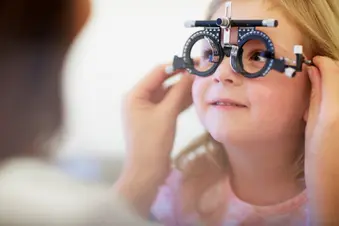
Myopia, also known as nearsightedness or shortsightedness, is common among children of all ages. Five percent of preschoolers, 9% of elementary-age children, and 30% of adolescents in the United States have myopia. And the numbers are rising. Researchers predict that by 2050, about half the people in the world will have myopia. This makes it important for parents to understand this vision issue.
Why Is Myopia on the Rise?
There are lots of theories about why more children are becoming nearsighted. We know that when children play outside more, their risk of myopia drops.
Outdoor time is good for vision in several ways. When your eyes are exposed to sunlight, your body releases a chemical called dopamine. Researchers believe that dopamine affects the retina, a layer of cells at the back of the eye that receives light through the cornea and sends signals to the brain. The dopamine slows down lengthening of the eye (axial growth). When the eye lengthens into an oval shape rather than the round shape it should be, light rays don’t focus on the retina as they should, causing nearsightedness.
Sunshine also provides vitamin D. Some studies show that people with myopia have lower vitamin D levels than people without the condition. Researchers still need to learn more to see if there is a connection between the vitamin and myopia.
Finally, being outside gives kids a bigger picture. More and more of kids’ lives, including school, takes place on electronic devices, forcing their eyes to focus closely on small, bright screens. And it isn’t just electronics: Research shows that most of our activities are literally within arm’s reach, whether it’s screen time, reading, or other activities. Being outdoors allows kids to focus on things at different distances – a “workout” for the eye.
Regular Eye Exams May Spot Myopia Early
You may wonder when your child should start having regular eye exams. Schools often do some basic eye testing, but this isn’t a replacement for an eye exam from a professional optometrist.
If you have no reason to suspect any vision problems, experts recommend your child have a full eye exam between 6 months and their first birthday. The next one should happen before they start kindergarten.
But there are some situations when your child may need earlier or more frequent eye exams. This includes if your child was premature and developed retinopathy of prematurity, or ROP. Babies with ROP are at risk of getting high myopia.
Your child may also need to have earlier or more frequent eye exams if you or your pediatrician suspects there may be a vision problem. Another reason is if you or your other children wear glasses or were treated for conditions such as a “lazy eye” (amblyopia) or crossed eyes (strabismus).
Early Treatment Is Crucial
Getting effective treatment early is vital if your child has myopia. Preschool children use their vision to learn about the world around them. Once they enter school, good vision is important to learn effectively. In addition, if your child has severe myopia, they may be at risk for having more serious eye issues later in life.
Children who don’t get myopia treatment, or get it later, run the risk of struggling in school because they can’t see what’s being presented in class. They may not be able to do everyday activities that require distance vision, such as playing certain sports or learning how to drive. It may be harder for them to interact with their peers and make friends.
In addition, children with myopia could get associated eye diseases. One is retinal detachment, which is when the retina pulls away from the back of the eye. This is a medical emergency that could lead to blindness if it’s not treated as quickly as possible. There may be some long-term damage to vision if the detachment is closer to the center of the eye, even with treatment.
Between 5% and 15% of people with myopia have severe myopia, also called high myopia. This puts them at a higher risk of eye complications later in life that could affect their vision and even cause blindness. They include:
- Cataracts
- Glaucoma
- Macular degeneration
People with milder myopia can still get these conditions, but the risk is higher when myopia is more severe.
If you have concerns about your child’s vision, speak to your pediatrician. Early detection can help your child see the world more clearly.
Show Sources
Photo Credit: Westend61 / Getty Images
SOURCES:
American Academy of Ophthalmology: “Retina.”
American Optometric Association: “Infant Vision: Birth to 24 Months of Age.”
Cleveland Clinic: “When Should Your Child Have a First Eye Exam?” “Dopamine.”
The Lancet: “Association between digital smart device use and myopia: a systematic review and meta-analysis.”
HealthyChildren.org: “Myopia (Nearsightedness) in Children & Teens.”
Oregon Health & Science University: “Myopia on the rise, especially among children.”
Mayo Clinic: “Retinal detachment.”
Optometrists Network: “Can Outdoor Time Prevent Myopia?”
Pacific University Oregon: “Why Has Myopia Become More Common?”
MyKidsVision.org: “Health problems associated with myopia in babies and toddlers.”
Investigative Ophthalmology and Visual Science: “The Complications of Myopia: A Review and Meta-Analysis.”
Child Mind Institute: “Why Kids Need to Spend Time in Nature.”
University of Utah Health: “What is Myopia, and Why Does it Affect So Many Children? Screen Time is a Growing Concern.”